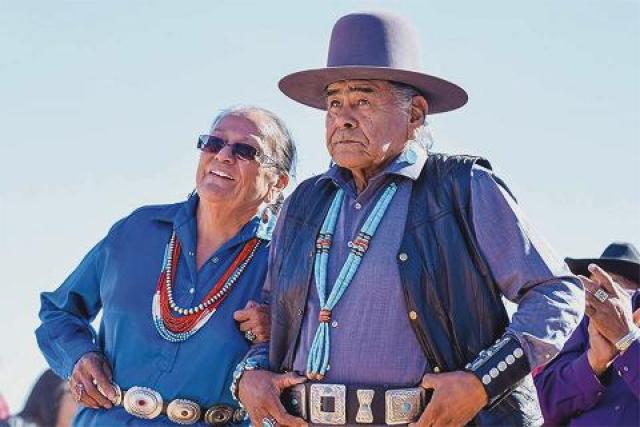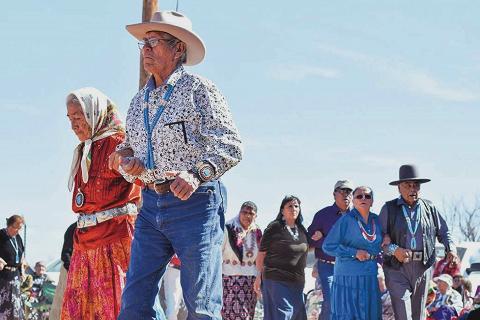 |
Canku Ota
|
 |
|
(Many Paths)
|
||
|
An Online Newsletter
Celebrating Native America
|
||
|
November 2017 - Volume
15 Number 11
|
||
|
|
||
|
Clothes Tell A Story
|
||
|
by Krista Allen - Navajo
Times
|
||
|
Bold colors,
eye-catching patterns at Utah fair Elder Fest
BLUFF, UT — Even though the Diné traditional style is fading away, it stood out through bold colors, vintage or handmade items and eye-catching patterns at the Elder Fest during the 28th annual Utah Navajo Fair. Louise Nez, 76, from Mariano Lake, New Mexico, says looking at what Diné men and women are wearing in each of the five agencies tells just as much about the state of things as the language does. "Men and women in Western Navajo have a style dating back to the olden days," Nez explained in Diné bizaad. "And men and women in Eastern Navajo wear contemporary clothing. Like the white man, they wear clothes they bought in stores such as pants, button-down shirts and sneakers. "And even the Navajo language," she added, "it's spoken differently throughout the Navajo Nation. People in Eastern speak differently than people in Western." From tl’aakal (skirts) to deiji’éé’ (blouses) to dootl’izhii (turquoise) to kélchí (moccasins), the stylish fairgoers over the weekend proved that events like the Elder Fest only tell half the story. "What I'm wearing, women wore in the olden days," Nez said in Diné bizaad as she showed the yoo’nilchíní (sterling buttons) on her blouse and the yoo’?ichi’í (red coral necklace) around her neck. She showed her concho belt, the fleecy fabric and the scarf she wore, which calculated a display of wealth. "Women in those days wore three- to four-tiered skirts," she said. At that point in time, Nez says, women's blouses were heavily embellished with yoo’nilchíní. "Nowadays, it's all nickel," she said. "Nowadays some women's clothing are immodest. That isn't Diné traditional style." |
|||||||
|
|
|
|
||
|
|
||
| Canku Ota is a free Newsletter celebrating Native America, its traditions and accomplishments . We do not provide subscriber or visitor names to anyone. Some articles presented in Canku Ota may contain copyright material. We have received appropriate permissions for republishing any articles. Material appearing here is distributed without profit or monetary gain to those who have expressed an interest. This is in accordance with Title 17 U.S.C. Section 107. | ||
|
Canku Ota is a copyright ©
2000 - 2017 of Vicki Williams Barry and Paul Barry.
|
||
 |
 |
|
|
The "Canku
Ota - A Newsletter Celebrating Native America" web site and
its design is the
|
||
|
Copyright ©
1999 - 2017 of Paul C. Barry.
|
||
|
All Rights Reserved.
|
||


